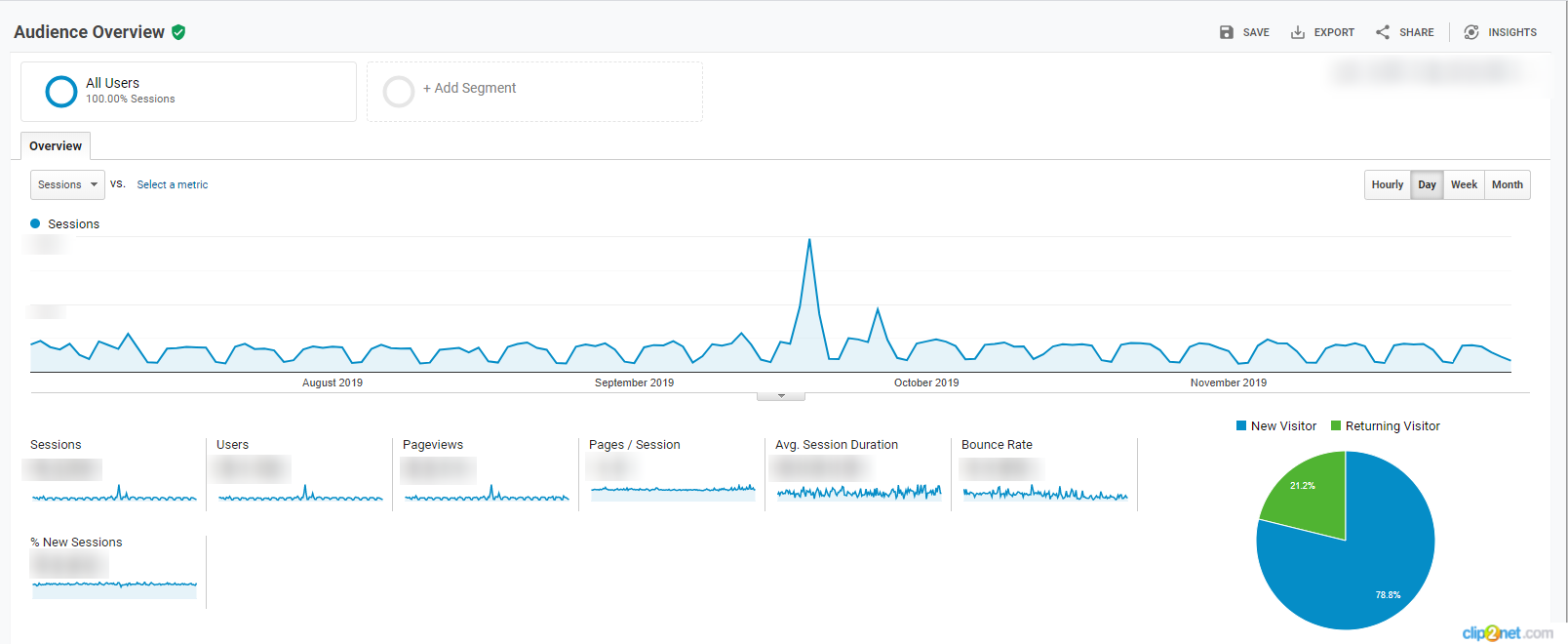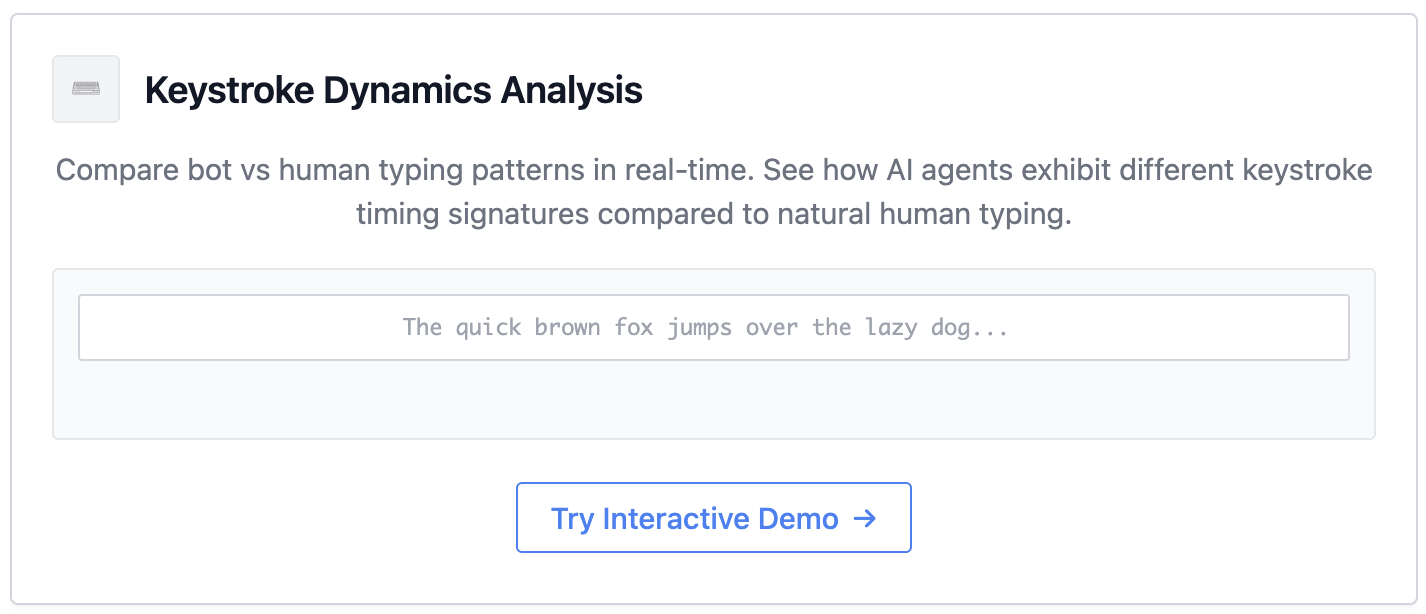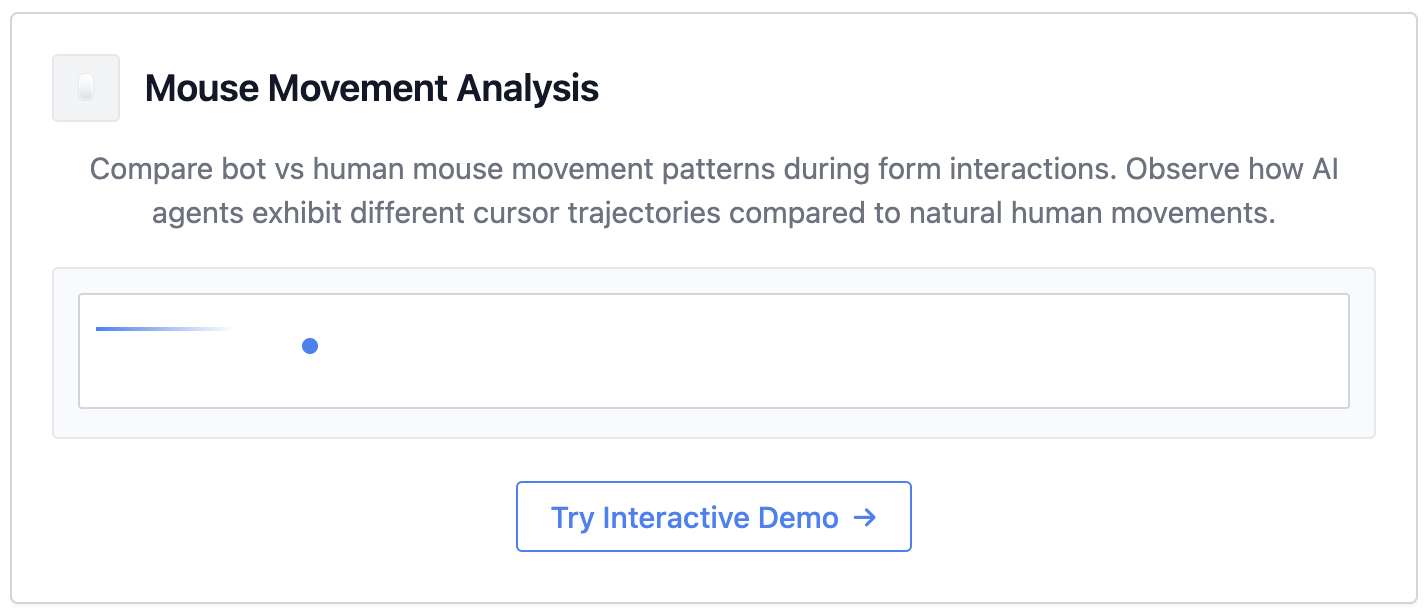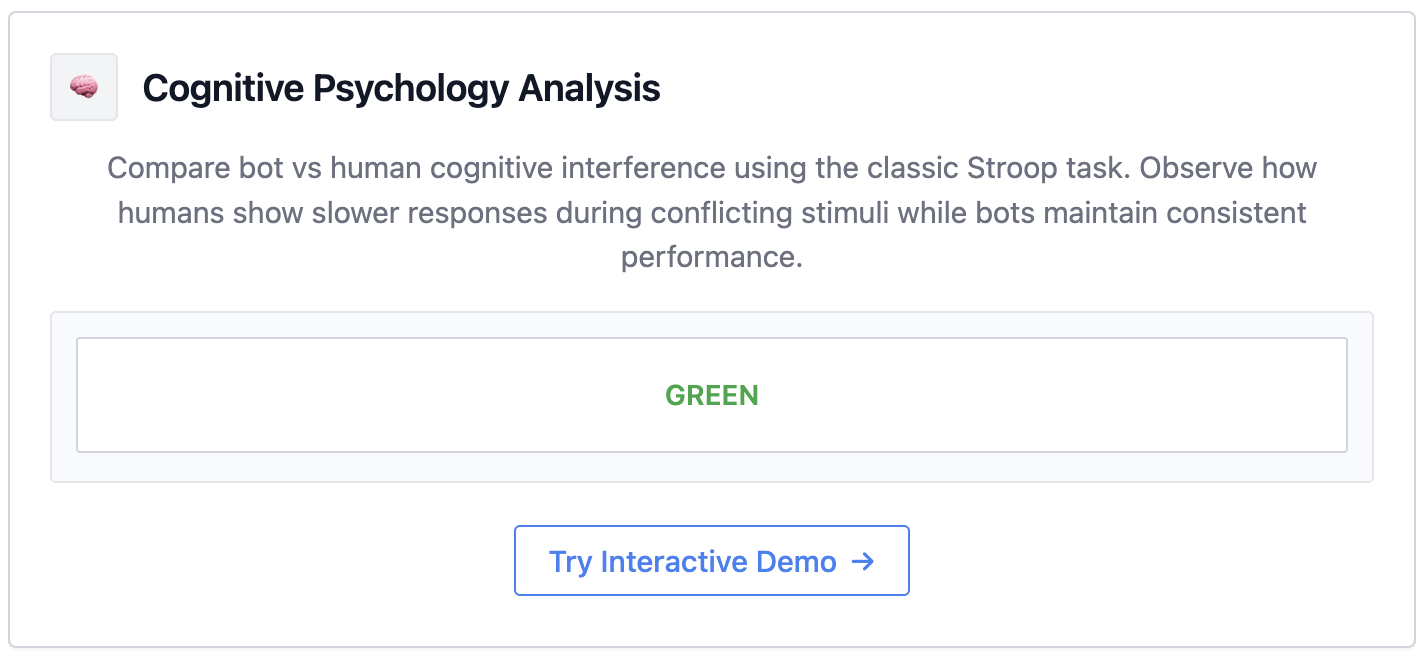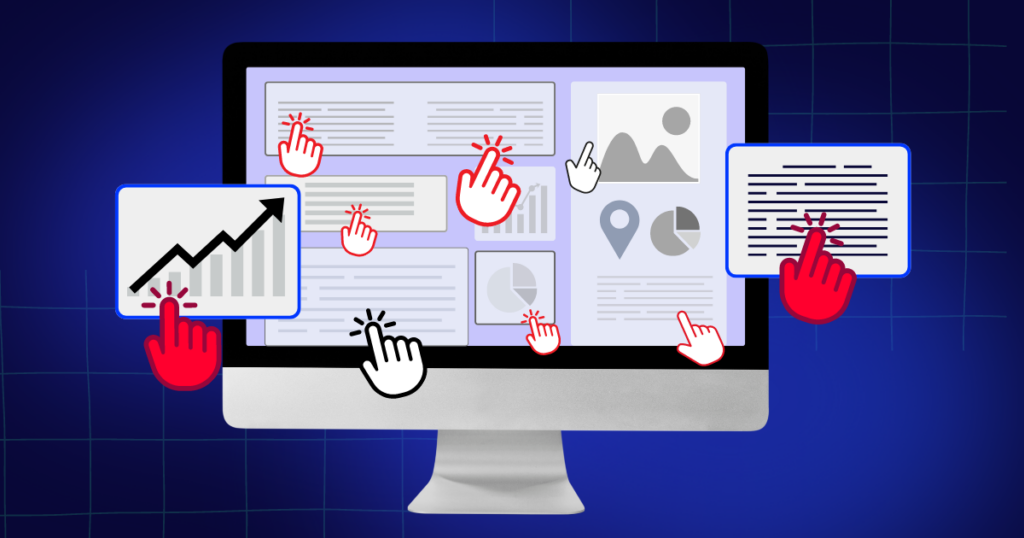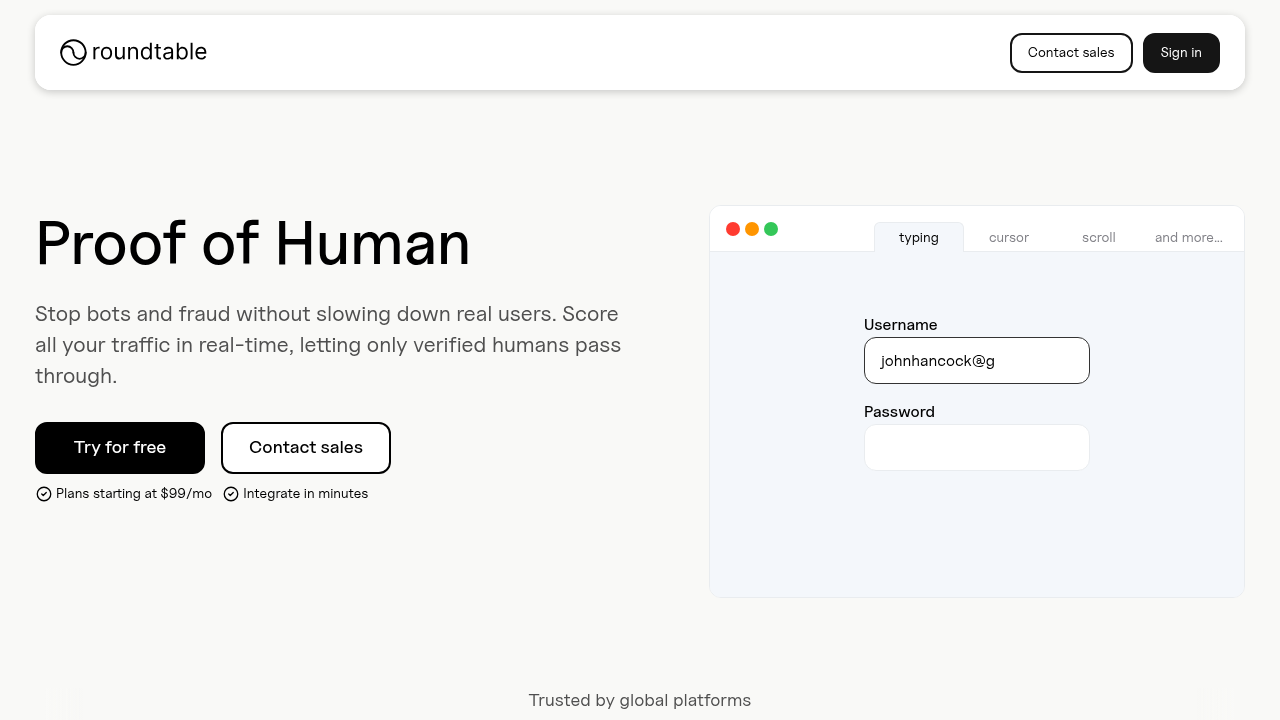10/27/2025. You've probably noticed your ad campaigns getting lots of clicks but no actual customers, and you're not imagining things. Click farms are systematically draining marketing budgets worldwide, using sophisticated combinations of human workers and AI bots to generate fake traffic that looks completely legitimate. The good news is that advanced detection systems can now identify the subtle behavioral patterns that reveal fraudulent activity, even when it's designed to fool traditional security measures.
Behavioral biometric solutions like Roundtable are finally giving businesses the tools they need to fight back against these increasingly sophisticated operations.
TLDR:
- Global ad-fraud losses caused by click farms were estimated at US$37.7 billion in 2024 and projected to rise to US$41.4 billion in 2025
- Watch for high click-through rates with zero conversions and traffic spikes from non-target regions
- Traditional IP blocking and CAPTCHAs fail against modern hybrid operations using human workers plus bots
- Behavioral analysis detects cognitive patterns that distinguish real users from systematic click farm activity
- Roundtable achieves 87% detection accuracy using invisible behavioral biometrics without user friction
Understanding Click Farms in 2025
Click farms are among the most persistent threats to digital advertising integrity. These operations involve groups of low-paid workers hired to create fake conversions, likes, reviews, and ad interactions, completely distorting online engagement metrics.
But with AI, the field has evolved dramatically. While traditional click farms relied on human workers manually clicking ads from rows of devices, today's operations blend human labor with sophisticated automation, creating hybrid networks that scale efficiently while mimicking authentic user behavior.
The economic incentives are enormous. According to Spider AF (2025 Ad Fraud White Paper),
global ad-fraud losses were estimated at $37.7 billion in 2024 and projected to rise to $41.4 billion in 2025. Some sources estimate even higher figures (e.g.,
$100 billion or more).
This massive revenue stream fuels continuous advancements in click farm tactics, with farms now operating across multiple countries, using time zone differences to maintain 24/7 activity while avoiding suspicious traffic spikes that might trigger automated detection systems. They also use real IP locations, device fingerprint rotation, and behavioral pattern variation to appear legitimate. Some farms even use AI to generate realistic user journeys, complete with browsing patterns and engagement sequences that fool basic detection systems.
How Click Farms Impact Your Business
Click farms waste ad spend, distorting ROI and CTR metrics and creating a false picture of campaign performance that leads to misguided strategic decisions.
When fake traffic inflates your funnel, customer acquisition costs skyrocket. While your analytics show healthy traffic volumes, you're paying for clicks that will never convert. This disconnect makes it nearly impossible to optimize campaigns effectively or allocate budget to genuinely profitable channels.
The data corruption extends beyond advertising metrics. Fake reviews, social media engagement, and website interactions poison your understanding of customer preferences and behavior patterns. Product decisions based on fraudulent feedback can lead you away from what real customers actually want. Brand reputation suffers as well when audiences recognize artificial engagement, with consumers getting increasingly better at spotting fake reviews and inflated social media metrics. Even if it's not your fault, it erodes trust in your brand's authenticity, with skepticism persisting long after you've fixed the click farm problem.
The worst part is that these impacts compound over time. Teams waste countless hours analyzing meaningless data, optimizing campaigns that were never reaching real users, and chasing growth metrics that don't actually translate to real business value.
Warning Signs of Click Farm Activity
Identifying click farm activity requires vigilant monitoring of specific behavioral patterns and traffic anomalies. The most obvious red flag is sudden traffic spikes from specific regions, especially areas where you don't typically see organic engagement. Geographic inconsistencies often reveal click farm operations. If you're suddenly receiving massive traffic from countries you don't target, or seeing engagement patterns that don't align with local time zones, you're likely dealing with fraudulent activity.
The conversion disconnect provides the clearest warning sign. Incredibly high click-throughs but absolutely no conversions indicate those clicks aren't from genuine customers. Legitimate users who click ads typically show some level of engagement or conversion activity.
| Warning Sign |
Description |
What to Look For |
| Traffic Spikes |
Sudden unexplained increases |
Volume jumps from specific regions |
| High CTR, Low Conversions |
Clicks without actions |
CTR above 5% with <1% conversion<="" td="">
|
| Repetitive Patterns |
Same behaviors repeated |
Identical session durations |
| Geographic Mismatches |
Traffic from wrong locations |
Clicks from non-target countries |
| Short Session Times |
Near-zero engagement |
Sessions under 10 seconds |
Behavioral uniformity across sessions also reveals automation. When you see identical session durations, perfectly consistent click patterns, or users following identical navigation paths, you're witnessing programmatic behavior instead of human decision-making.
To combat this, you'll need to monitor for impossible interaction speeds and patterns that violate human cognitive limitations. Real users need time to read, process information, and make decisions. An
invisible human verification system can help identify these subtle but important differences between human and automated interactions.
Traditional Detection Methods and Their Limitations
So how do you combat click farms when manual methods or basic filters often miss sophisticated invalid traffic or sophisticated attacks? It starts with detection, but many of these methods have limitations:
- IP blocking is the most basic defense against click farms, but its effectiveness has dropped considerably. Administrators blacklist suspicious IP locations after detecting fraudulent activity, creating a reactive approach that's always one step behind attackers. The main flaw lies in how easy it is to get around. Click farms counter this strategy by using VPNs and proxy servers to mask their IP locations, making clicks appear to originate from diverse, legitimate sources. Residential proxy networks now provide access to millions of real IP locations, making geographic filtering nearly impossible.
- CAPTCHA systems face similar challenges against hybrid click farm operations. While traditional invisible CAPTCHA solutions can stop basic bots, they're powerless against human workers in click farms who can solve puzzles as easily as legitimate users.
- Traffic analysis based on volume patterns and timing falls short against distributed operations. Modern click farms spread activity across multiple time zones and vary interaction patterns to mimic organic user behavior. Simple rate limiting becomes ineffective when attacks distribute across thousands of IP locations.
- Device fingerprinting offers limited protection since click farms regularly rotate devices and clear browser data. Advanced operations use virtual machines and automated fingerprint spoofing to appear as unique users for each interaction.

Unfortunately, the arms race continues to escalate. As detection methods improve, click farms adapt with more sophisticated evasion techniques, creating an endless cycle where traditional reactive approaches consistently lag behind evolving threats.
Advanced Detection Technologies
Thankfully, there are advanced technologies to improve the detection of click farms. These include:
- Behavioral analysis systems
- Device intelligence and fingerprinting
The most sophisticated systems connect behavioral patterns with device characteristics, making it significantly harder for fraudsters to maintain convincing facades across large-scale operations.
Behavioral Analysis Systems
Modern detection systems use AI-based behavioral biometrics to analyze the subtle patterns that distinguish human users from click farm operations. These systems look at keystroke dynamics, measuring the precise timing between key presses and releases that create unique digital fingerprints for each user.
Similarly, mouse movement analysis reveals important differences between human and automated interactions. Genuine users show micro-corrections, slight hesitations, and natural acceleration curves that bots struggle to replicate convincingly. Click farm workers, even when manually operating devices, often display repetitive patterns that betray their systematic approach.
Interaction timing patterns expose the cognitive delays inherent in human decision-making. Real users pause to read content, consider options, and move around based on visual cues. Automated systems and trained click farm workers typically show unnaturally consistent timing that violates human cognitive limitations.
Advanced systems like
Roundtable Proof of Human continuously monitor these behavioral signals throughout entire sessions, building detailed profiles that distinguish authentic engagement from fraudulent activity.
Device Intelligence and Fingerprinting
Device intelligence combines behavioral data with hardware characteristics to create multi-layered detection systems. These approaches identify device farms by recognizing when multiple accounts operate from identical hardware configurations or exhibit suspiciously similar environmental signatures.
Advanced fingerprinting techniques analyze screen resolution, browser features, installed fonts, and hardware specifications to detect when click farms attempt to simulate diverse user environments from limited device pools.
Prevention Strategies and Best Practices
Effective click farm prevention requires a multi-layered approach combining technical safeguards with strategic campaign management. The foundation starts with implementing real-time fraud detection solutions that identify and block invalid clicks before they drain your budget. Once you have that foundation in place, there are four best practices to help you most effectively prevent click farm fraud from impacting your business:
- Campaign targeting refinement serves as your first line of defense. Restrict geographic targeting to regions where you have genuine business presence and customer demand. Avoid broad, untargeted campaigns that attract click farm attention through their high visibility and loose qualification criteria.
- Budget management becomes critical when dealing with potential fraud. Set daily spending limits and implement automated pause triggers when campaigns exceed normal cost-per-acquisition thresholds. This prevents click farms from consuming entire monthly budgets in single fraudulent bursts.
- Partner vetting requires thorough due diligence on advertising networks and traffic sources. Work exclusively with reputable networks that maintain strict quality standards and provide transparent reporting on traffic sources.
- Continuous monitoring through automated detection systems allows rapid response to new threats. Set up alerts for unusual traffic patterns, conversion rate drops, and geographic anomalies that signal potential click farm activity.
The table below provides an overview of these prevention methods, how to implement, and how effective they are.
| Prevention Method |
Implementation |
Effectiveness |
| Behavioral Analysis |
Deploy advanced detection APIs |
High accuracy for human patterns |
| IP Filtering |
Block suspicious IP ranges |
Moderate, easily circumvented |
| Geographic Targeting |
Restrict campaign locations |
Good for basic filtering |
| Budget Caps |
Set daily spending limits |
Prevents major losses |
| Partner Vetting |
Verify ad network legitimacy |
Critical for quality traffic |
The best solution is to use a layered approach. This combines multiple detection and prevention methods, so that if one system fails, others maintain protection against evolving click farm tactics.
Comparing Click Farm Detection Solutions
Deploying effective click farm detection and mitigation starts with selecting the right technical approach for your infrastructure. Optimal risk detection involves combining rich data intelligence with powerful analytics to discern intent and behavior in real-time, requiring careful integration planning. As you choose a solution for click farm detection, keep in mind three key areas of consideration:
- Integration requirements
- Threshold and geographic configuration
- Clear detection results
Integration Requirements
Modern detection systems like
Roundtable's API offer simple deployment through single-line JavaScript integration. This approach minimizes engineering overhead while providing immediate protection against click farm activity. Start by identifying your highest-risk traffic sources and user interaction points. Focus initial implementation on ad landing pages, registration forms, and conversion funnels where click farm impact creates the most financial damage.
Threshold and Geographic Configuration
Threshold configuration requires balancing detection sensitivity with false positive rates. Begin with conservative settings that catch obvious click farm patterns, then gradually increase sensitivity as you understand your legitimate user behavior patterns. We recommend that you set initial detection thresholds at 70% confidence to catch clear click farm activity while minimizing disruption to genuine users during the learning period.
Session duration thresholds need calibration based on your content complexity. E-commerce sites typically see longer legitimate sessions than simple landing pages, requiring different baseline expectations for normal user behavior.
Finally, geographic filtering should align with your actual business presence. Configure detection systems to flag traffic from regions where you don't operate, while allowing legitimate international customers through manual review processes.
Clear Detection Results
Effective implementation depends on understanding detection system outputs and acting appropriately on different risk levels. High-confidence detections warrant immediate blocking, while moderate scores may require additional verification steps. If the solution doesn't present this data in a way that is actionable, it may not be the solution you need.
Make sure to also monitor detection patterns over time to identify new click farm tactics and adjust configurations accordingly. For borderline cases where automated systems lack sufficient confidence for definitive decisions, it's critical for humans to remain, even if only cursorily, in the review processes.
Why Roundtable Excels at Click Farm Detection
Roundtable's Proof of Human technology tackles the fundamental challenge that makes click farms so effective: distinguishing genuine human behavior from both automated systems and trained human workers executing repetitive tasks.
The system continuously monitors user behavior patterns including keystroke dynamics, mouse movement, and scrolling throughout each session. This approach catches the subtle behavioral tells that reveal click farm operations, even when human workers are involved. Traditional detection methods fail against hybrid click farms because they focus on obvious automation signals. Roundtable's behavioral biometrics detect the cognitive patterns that separate authentic user engagement from systematic click farm execution, regardless of whether humans or bots perform the actions.
According to our own testing, Roundtable achieved 87%
bot detection accuracy versus Google reCAPTCHA's 69% and Cloudflare Turnstile's 33%, providing superior protection against sophisticated click farm operations.
The invisible operation eliminates the friction that drives users away from legitimate interactions. While click farms can solve CAPTCHAs as easily as real users, they cannot replicate the complex behavioral signatures that Roundtable analyzes during natural user interactions.
Privacy protection remains most important throughout the detection process. The system operates without collecting personally identifiable information or cross-site tracking, focusing exclusively on behavioral signals that indicate human authenticity.
Roundtable's continuous behavioral analysis creates an insurmountable challenge for click farm operations, as replicating authentic human cognitive patterns across thousands of interactions becomes economically unfeasible.
FAQ
How can I tell if my campaigns are being targeted by click farms?
Look for high click-through rates (above 5%) combined with extremely low conversion rates (under 1%), sudden traffic spikes from regions you don't target, and sessions lasting under 10 seconds with no meaningful interactions. These patterns indicate fraudulent activity instead of genuine user engagement.
What's the difference between traditional bot detection and behavioral analysis for click farms?
Traditional methods like IP blocking and CAPTCHAs can be easily bypassed by click farms using VPNs and human workers who solve puzzles normally. Behavioral analysis looks at subtle patterns like keystroke timing and mouse movements that reveal systematic behavior, making it effective against both automated bots and trained human workers.
How quickly can I implement click farm detection on my website?
Modern solutions like Roundtable's API can be deployed in minutes using a single-line JavaScript integration. Start with conservative detection thresholds at 70% confidence to catch obvious click farm activity, then gradually increase sensitivity as the system learns your legitimate user patterns.
Why do click farms still use human workers instead of just bots?
Hybrid operations combine human workers for complex tasks that require cognitive responses (like solving CAPTCHAs or moving through different interfaces) while using bots for high-volume repetitive clicks. This approach helps them bypass basic detection systems while maintaining the scale needed for profitable fraud operations.
Can behavioral detection systems work without collecting personal data?
Yes, advanced behavioral analysis focuses exclusively on interaction patterns like typing rhythm and mouse movements instead of personal information. Systems like Roundtable's Proof of Human operate without collecting PII or cross-site tracking, maintaining privacy compliance while detecting fraudulent behavior.
Final thoughts on protecting your business from click farm fraud
Click farms will continue evolving their tactics, but understanding their methods gives you the power to fight back effectively. The key lies in moving beyond basic detection methods toward behavioral analysis that catches the subtle patterns fraudsters can't replicate at scale. When your campaigns are protected from fake traffic, every dollar you spend drives
toward actual business value instead of padding fraudsters' profits. Your marketing metrics become trustworthy again, and your growth becomes sustainable.


